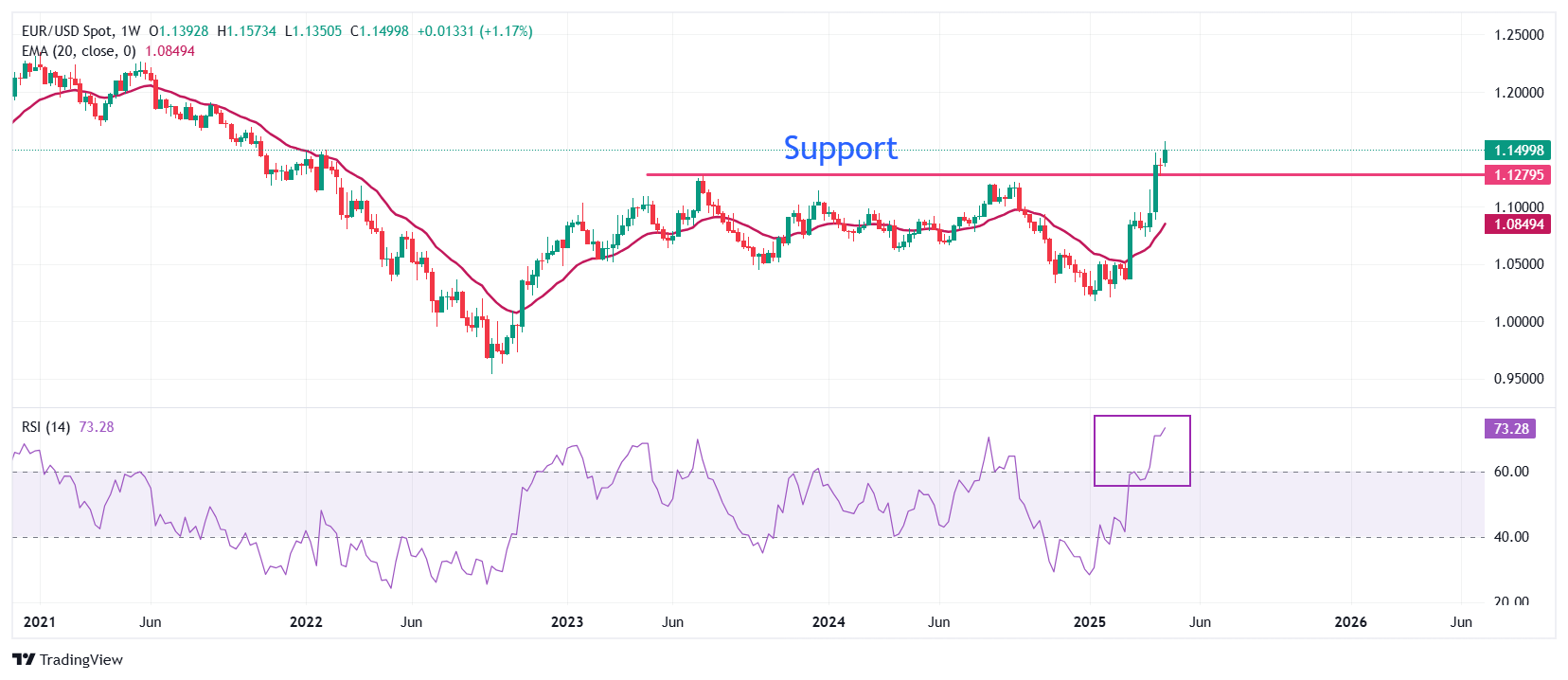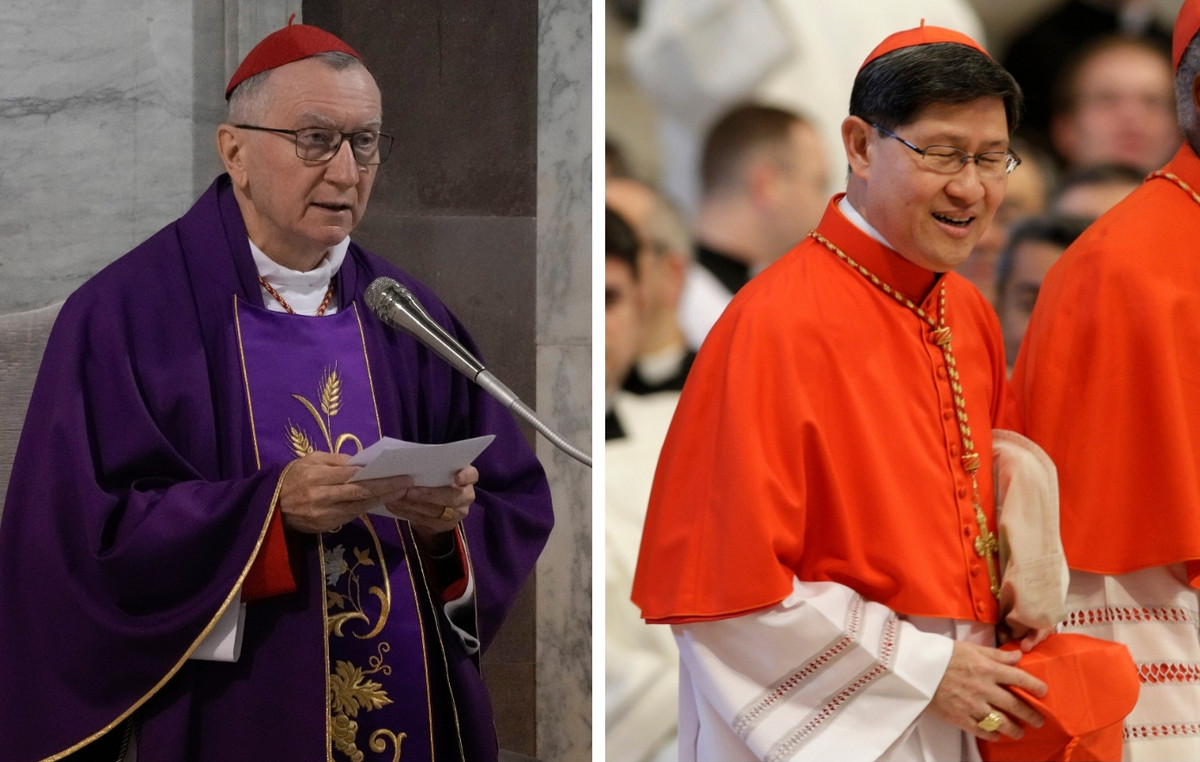- EUR/USD is kept in profits about 1,1500 while the US dollar has been beaten by Trump’s attack on the independence of the Fed.
- Trump blames Fed and Powell for the possible economic slowdown in the USA.
- The ECB is expected to cut interest rates in June due to the growing downward risks for eurozone inflation.
The EUR/USD firmly quotes around 1,1500 during the European negotiation hours on Tuesday. The main currency pair breathes relieved after a strong rebound in recent weeks. The torque seems to be preparing for a new upward movement, since the US dollar (USD) is expected to continue facing the load of the growing tensions between the Federal Reserve (Fed) and the US president Donald Trump on monetary policy.
The American dollar index (DXY), which tracks the value of the dollar against six main currencies, seeks to find a support after reaching a minimum of three years about 98.00.
The president of the United States Trump continues to criticize the president of the FED, Jerome Powell, for not lowering interest rates and warned that the economy could face a recession if they are not immediately reduced.
“With these costs in downward trend, as I predicted, there can hardly be inflation, but there may be a slowdown of the economy unless Mr. Too late, a great loser, lowers interest rates, now,” Trump wrote in a Truthsocial publication on Monday.
Meanwhile, Jerome Powell has been supporting to keep interest rates in the current range of 4.25% -4.50% until it is clear if the inflation driven by new economic policies is persistent or temporary.
President Trump has also threatened to dismiss Powell a year before he finished his mandate for not lowering interest rates. It is still discussed if Donald Trump can fire Powell, but the situation will continue to be the same, since the decision on interest rates will eventually be taken by other members of the Fed, and none of them has talked about relaxing monetary policy immediately.
The signals of political interference in the Fed operations, which is an autonomous institution, have led to a strong decrease in the status of safe refuge of the US dollar. Investors doubt the credibility of the US dollar and US assets under the threat of Trump’s attack on the independence of the Fed.
Daily summary of market movements: EUR/USD is firm at the expense of the US dollar
- The EUR/USD clings to the profits about 1,1500 at the expense of the US dollar, whose safe shelter status has been questioned due to the events of constantly changing rates holders by Donald Trump and his dispute with Powell of the Fed. Trump announced a 90 -day pause in the execution of reciprocal fees after receiving answers from their commercial partners to make a fair deal. However, the commercial war intact between the US and China has kept the US dollar at a disadvantage.
- The impact of the intensified trade war between the two greatest powers in the world has hit the global economic perspectives, including that of the US, since US importers will support the highest rates load, which will transfer consumers. Such scenario will significantly reduce the purchasing power of households.
- During European negotiation hours, the euro (EUR) is quoted with caution, since the operators have become increasingly confident that the European Central Bank (ECB) could cut interest rates again at the June policy meeting. Moderate BCE bets have increased in the face of the growing downward risks for eurozone inflation in the midst of global economic agitation fears.
- Citi analysts anticipated a 1.6% price growth next year and 1.8% in 2027 last week before the decision on ECB’s interest rates on Thursday. These predictions were given before the BCE monetary policy announcement, in which the Central Bank reduced its key interest rates for the seventh time in the current monetary relaxation cycle and guided a gloomy economic perspective.
- At the press conference, the president of the ECB, Christine Lagarde, warned that the downward risks for the eurozone economy have increased. Lagarde said that the economic perspective is “clouded by uncertainty” since commercial interruptions would weigh on “business investment.”
- Looking ahead, the next trigger for the euro will be the preliminary purchasing managers index (PMI) and its nations for April, which will be published on Wednesday.
Technical analysis: EUR/USD firmly trades about 1,1500

The EUR/USD clings to the profits about 1,1500 in the European session on Tuesday. The main currency pair was strengthened after a breakout above the maximum of April 11, 1,1474. The 20 -week exponential (EMA) mobile average about 1,0850 suggests a strong upward trend.
The 14 -week relative force (RSI) index rises to overstrobra levels around 75.00, indicating a strong bullish impulse, but possibilities of any correction cannot be ruled out.
Looking up, the round level of 1,1600 will be the main resistance for the torque. On the contrary, the maximum of July 2023 of 1,1276 will be a key support for the euros of the euro.
Euro Faqs
The euro is the currency of the 19 countries of the European Union that belong to the Eurozone. It is the second most negotiated currency in the world, behind the US dollar. In 2022, it represented 31 % of all foreign exchange transactions, with an average daily business volume of more than 2.2 billion dollars a day. The EUR/USD is the most negotiated currency pair in the world, with an estimate of 30 %of all transactions, followed by the EUR/JPY (4 %), the EUR/GBP (3 %) and the EUR/AU (2 %).
The European Central Bank (ECB), based in Frankfurt (Germany), is the Eurozone reserve bank. The ECB establishes interest rates and manages monetary policy. The main mandate of the ECB is to maintain price stability, which means controlling inflation or stimulating growth. Its main tool is the rise or decrease in interest rates. Relatively high interest rates (or the expectation of higher types) usually benefit the euro and vice versa. The GOVERNMENT BOOK of the ECB makes decisions about monetary policy in meetings that are held eight times a year. The decisions are made by the directors of the National Banks of the Eurozone and six permanent members, including the president of the ECB, Christine Lagarde.
Eurozone inflation data, measured by the harmonized consumer prices index (IPCA), are an important economic indicator for the euro. If inflation increases more than expected, especially if it exceeds 2% of the ECB, it forces the ECB to rise interest rates to control it again. Relatively high interest rates compared to their counterparts usually benefit the euro, since they make the region more attractive as a place for global investors to deposit their money.
Published data measure the health of the economy and can have an impact on the euro. Indicators such as GDP, manufacturing and services PMIs, employment and consumer trust surveys can influence the direction of the single currency. A strong economy is good for the euro. Not only attracts more foreign investment, but it can encourage the ECB to raise interest rates, which will directly strengthen the euro. Otherwise, if economic data is weak, the euro is likely to fall. The economic data of the four largest economies in the euro zone (Germany, France, Italy and Spain) are especially significant, since they represent 75% of the economy of the euro area.
Another important fact that is published on the euro is the commercial balance. This indicator measures the difference between what a country earns with its exports and what you spend on imports during a given period. If a country produces highly demanded export products, its currency will gain value simply by the additional demand created by foreign buyers seeking to buy those goods. Therefore, a positive net trade balance strengthens a currency and vice versa in the case of a negative balance
Source: Fx Street
I am Joshua Winder, a senior-level journalist and editor at World Stock Market. I specialize in covering news related to the stock market and economic trends. With more than 8 years of experience in this field, I have become an expert in financial reporting.







